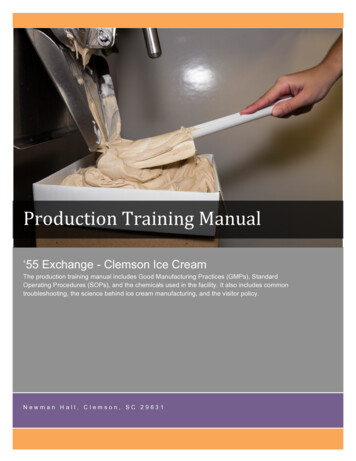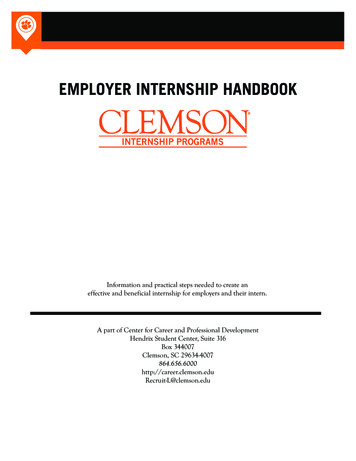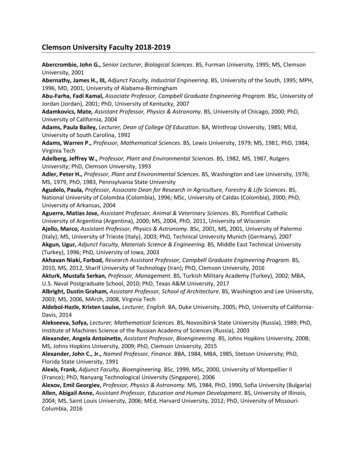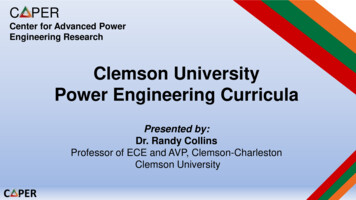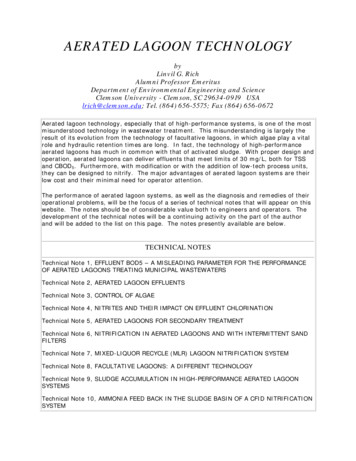
Transcription
AERATED LAGOON TECHNOLOGYbyLinvil G. RichAlumni Professor EmeritusDepartment of Environmental Engineering and ScienceClemson University - Clemson, SC 29634-0919 USAlrich@clemson.edu; Tel. (864) 656-5575; Fax (864) 656-0672Aerated lagoon technology, especially that of high-performance systems, is one of the mostmisunderstood technology in wastewater treatment. This misunderstanding is largely theresult of its evolution from the technology of facultative lagoons, in which algae play a vitalrole and hydraulic retention times are long. In fact, the technology of high-performanceaerated lagoons has much in common with that of activated sludge. With proper design andoperation, aerated lagoons can deliver effluents that meet limits of 30 mg/L, both for TSSand CBOD5. Furthermore, with modification or with the addition of low-tech process units,they can be designed to nitrify. The major advantages of aerated lagoon systems are theirlow cost and their minimal need for operator attention.The performance of aerated lagoon systems, as well as the diagnosis and remedies of theiroperational problems, will be the focus of a series of technical notes that will appear on thiswebsite. The notes should be of considerable value both to engineers and operators. Thedevelopment of the technical notes will be a continuing activity on the part of the authorand will be added to the list on this page. The notes presently available are below.TECHNICAL NOTESTechnical Note 1, EFFLUENT BOD5 – A MISLEADING PARAMETER FOR THE PERFORMANCEOF AERATED LAGOONS TREATING MUNICIPAL WASTEWATERSTechnical Note 2, AERATED LAGOON EFFLUENTSTechnical Note 3, CONTROL OF ALGAETechnical Note 4, NITRITES AND THEIR IMPACT ON EFFLUENT CHLORINATIONTechnical Note 5, AERATED LAGOONS FOR SECONDARY TREATMENTTechnical Note 6, NITRIFICATION IN AERATED LAGOONS AND WITH INTERMITTENT SANDFILTERSTechnical Note 7, MIXED-LIQUOR RECYCLE (MLR) LAGOON NITRIFICATION SYSTEMTechnical Note 8, FACULTATIVE LAGOONS: A DIFFERENT TECHNOLOGYTechnical Note 9, SLUDGE ACCUMULATION IN HIGH-PERFORMANCE AERATED LAGOONSYSTEMSTechnical Note 10, AMMONIA FEED BACK IN THE SLUDGE BASIN OF A CFID NITRIFICATIONSYSTEM
Technical Note Number 1EFFLUENT BOD5 – A MISLEADING PARAMETER FOR THEPERFORMANCEOF AERATED LAGOONS TREATING MUNICIPALWASTEWATERSbyLinvil G. RichAlumni Professor EmeritusDepartment of Environmental Engineering and ScienceClemson University - Clemson, SC 29634-0919 USAlrich@clemson.edu; Tel. (864) 656-5575; Fax (864) 656-0672In spite of the fact that effluent BOD5 is a key parameter in many discharge permits foraerated lagoons, it is the most misleading. Most effluent BOD5 data are flawed as the resultof being inflated by nitrification that occurs in the BOD5 test itself. It has been reported thatas many as 60 percent of the BOD5 violations nationally may have been caused bynitrification in the BOD5 test rather than by improper design or operation (Hall and Foxen1983). Consequently, millions of dollars may have been spent needlessly on new treatmentfacilities.The total BOD of a wastewater is composed of two components – a carbonaceous oxygendemand and a nitrogenous oxygen demand. Traditionally, because of the slow growth ratesof those organisms that exert the nitrogenous demand, it has been assumed that nonitrogenous demand is exerted during the 5-day BOD5 test. Although, such assumption isvalid when the test is performed on untreated municipal wastewaters, it is not valid whenperformed on secondary effluents, especially those from aerated lagoons. The BOD5 ofeffluents from the latter are almost always inflated by a nitrogenous component. Moreover,unlike the carbonaceous demand which is proportional to the concentration of thebiodegradable carbon constituents in the effluent, the nitrogenous demand exerted duringthe 5-day test is proportional to the number of nitrifying organisms that happen to becaught in the sample being tested. Thus the argument that the test provides insight on theimpact that the effluent will have on the receiving water can not be defended. Neither canthe practice of making waste-load allocations from models that contain both a BOD5(assumed to be a measure of the carbonaceous demand) and a nitrogenous demand.The severity of the problem is illustrated in Figs. 1 and 2. Figure 1 compares the effluentBOD5 with the CBOD5 (carbonaceous component of the BOD5). The CBOD5 is determined byusing a nitrification suppressant in the BOD5 test. Figure 2 compares the two parameters infiltered samples. Note should taken of the magnitude of the nitrification factor in the 5-daytest. Similar magnitudes are observed in effluents from aerated lagoons in warmerclimates.2
Figure 1. Effluent BOD5 and CBOD5 data from an aerated lagoon system in Maine that treatsa domestic wastewater. (Courtesy of George Bloom, Woodard and Curran, Engrs. Takenfrom Rich (1999))Figure 2. Effluent SBOD5 and SCBOD5 data from an aerated lagoon system in Maine thattreats a domestic wastewater. (Courtesy of George Bloom, Woodard and Curran, Engrs.Taken from Rich (1999))Nitrification in the BOD5 test has been thoroughly researched and documented (Young1973; Dague 1981; Barth 1981; Carter 1983; Chapman et al. 1991). Such nitrification canbe eliminated by the use of commercially available nitrification inhibitors, a practicerecommended by Standard Methods (1995). Chapman et al. (1991) demonstrated that bycleaning the sampler tubing weekly with chlorine bleach, nitrification in the BOD5 test can bereduced. The U.S. EPA has given their approval to the use of a nitrification inhibitor,provided that the effluent permit states the limit in terms of the CBOD5 instead of theBOD5. Arguing that secondary BOD5 limits were initially established on the basis of valuesflawed by nitrification, the EPA has suggested that the CBOD5 limit for secondary treatment3
be 25 mg/L rather than the 30 mg/L allowed when the limit is stated in terms of BOD5 (Halland Foxen 1983). Considering the fact that the nitrification component of the BOD5 isgenerally at least 5 mg/L and frequently as high as 50 mg/L, the 25 mg/L limit appears toimpose no handicap.In summary, BOD5 is an ambiguous parameter when applied to secondary effluents,especially those of aerated lagoons, and should not be used. Instead, use should be madeof the CBOD5 test which specifically measures the concentration of the biodegradablecarbonaceous materials.REFERENCESBarth, E. F. (1981). “To inhibit or not to inhibit: that is the question.” J. Wat. Pollut. ControlFed., 53(11), 1651-1652.Carter, K. B. (1984). “30/30 hindsight.” J. Wat. Pollut. Control Fed., 56(4), 301-305.Chapman et al. (1991). “Minimizing the impact of nitrification in nitrifying wastewaters.”Operations Forum, WPCF, Sept. 14-16.Dague, R. E. (1981). “Inhibition of nitrogenous BOD and treatment plant performanceevaluation.” J. Wat. Pollut. Control Fed., 53(12), 1738-1741.Hall, J. C. and Foxen, R. J. (1983). “Nitrification in the BOD test increases POTWnoncompliance.” J. Wat. Pollut. Control Fed., 55(12), 1461-1469.Rich, L. G. (1999). High Performance Aerated Lagoon Systems. American Academy ofEnvironmental Engineers.Young, J. C. (1973). “Chemical methods for nitrification control.” J. Wat. Pollut. ControlFed., 45(4), 637-646.4
Technical Note Number 2AERATED LAGOON EFFLUENTSbyLinvil G. RichAlumni Professor EmeritusDepartment of Environmental Engineering and ScienceClemson University - Clemson, SC 29634-0919 USAlrich@clemson.edu; Tel. (864) 656-5575; Fax (864) 656-0672There are two great myths in aerated lagoon technology. The first myth is that effluentBOD5 measures the biodegradable carbonaceous material in the effluent. The fallacy of thismyth was discussed in Technical Note Number 1. Practically all effluent BOD5 values areinflated by nitrification that occurs in the 5-day BOD5 test itself. Such inflation is avoided byusing the CBOD5 test in which nitrification is suppressed. The second myth is that theeffluent BOD5, or CBOD5, is the residual of the BOD5 in the influent to the lagoon. In fact,most of the effluent CBOD5 is the result of algae that grows in the lagoon. By discardingthese two myths, one is in a much better position to understand the performance of aeratedlagoon.For domestic wastewaters, the BOD5, or CBOD5, in the influent to a lagoon system consistsof two fractions – a particulate fraction consisting of 70 to 80 percent of the total, and asoluble fraction, making up the remainder. In an aerated lagoon cell in which all settleablesolids are maintained in suspension by aeration, the removal of the particulate fraction isvery rapid, probably no more than 4 to 5 hours. Removal is the result of the physicalcapture and adsorption by the suspended floc. The time required for the removal of thesoluble fraction is somewhat longer, but still quite rapid. The mechanism involved here, isthe assimilation of the organic materials for growth.Attention is directed to Fig. 1. The data points shown there illustrate the soluble BOD5remaining in the effluent of a full-scale aerated lagoon treating a domestic wastewater atdifferent hydraulic retention times for a range of temperatures varying from 16 to 20 C(Fleckseder and Malina 1970). The curve in Fig. 1 is a plot of an equation that predicts theeffluent BOD5 (Rich 1991) using coefficients determined by Jorden et al. (1971) fordomestic wastewaters at 20 C. The equation, and, hence the prediction, was developed onthe assumption that the BOD5 values truly represented the carbonaceous demand. As wasdiscussed in Technical Note Number 1, the BOD5 values in the plot were most likely to havebeen inflated by nitrification in the 5-day test. Therefore, the curve is seen to provide aconservative estimate of the soluble BOD5, let alone the soluble CBOD5. From the figure, itis obvious that the residual of the CBOD5 in the influent that is found in the effluent will bequite small.5
Figure 1. Effluent soluble BOD5 as a function of the hydraulic retention time. (Taken fromRich (1993))Municipal wastewaters have an abundance of nitrogen and phosphorus, and, thus,when treated in lagoon systems with excessive hydraulic retention times, provide an optimalenvironment for the growth of algae. The concentration of algae in the effluent is reflectedin the magnitude of the total suspended solids (TSS). In the absence of algae, the TSS ofthe effluent of a lagoon system with a terminal settling cell will normally be less than 10mg/L. Not only will algae increase effluent TSS, they will also increase the CBOD5. Suchincrease is the result of the respiration of algae during the 5-day test. On the average(Toms et al. 1975),CBOD5 0.5 TSS(1)In summary, most of the TSS and CBOD5 in the effluents of lagoons is caused byalgae growing in the lagoon. Very little, if any, TSS and CBOD5 in the effluents are residualsof the TSS and CBOD5 that enter the lagoon. Figure 2 illustrates the impact that nitrificationin the BOD5 test and algae have on the effluent BOD5 of an aerated lagoon system locatedin South Carolina. The values with the legend "ABOD5" were the effluent CBOD5 valueswhereas those with the legend "NBOD5" were derived from the differences in the BOD5 andthe CBOD5 values.6
Figure 2. Effluent BOD5 and its components - BOD5 caused by algal respiration (ABOD5)and BOD5 caused by nitrification in the BOD5 (NBOD5).Reconstructing Performance RecordsAs discussed in Technical Note Number 1, effluent BOD5 is worthless as a performanceparameter. Consequently, most historical records in terms of this parameter are of littlevalue in determining performance, especially for aerated lagoons. However, approximateperformance records in terms of CBOD5 can be reconstructed using effluent TSS data.The effluent CBOD5 can be estimated, usingCBOD5 SCBOD5 0.5 TSS(2)where SCBOD5 is the soluble CBOD5. It is seen in Fig. 2 of Technical Note Number 1 thatthe SCBOD5 component of CBOD5 is generally less than 10 mg/L. Thus, if an aeratedlagoon had an effluent TSS of 50 mg/L, the effluent CBOD5 can be estimated roughly asbeingCBOD5 10 0.5(50) 35 mg/L(3)REFERENCESFleckseder, H. R. and Malina, J. F. (1970). "Performance of the aerated lagoon process."Technical Report CRWR-71, Center for Research in Water Resources, University of Texas,Austin, TX.7
Jorden, W. L. et al. (1971). "Evaluating treatability of elected industrial wastes." Proc. 26thAnnual Purdue Indust. Wastes Conf., Purdue University, Lafayette, IN.Rich, L. G. (1993). "Technical Note No. 1, Aerated Lagoons". Office of ContinuingEngineering Education, Clemson University, Clemson, SC.Toms, I. P. et al. (1975). "Observations on the performance of polishing ponds." WaterPollution Control, 74, 383-401.8
Technical Note Number 3CONTROL OF ALGAEbyLinvil G. RichAlumni Professor EmeritusDepartment of Environmental Engineering and ScienceClemson University - Clemson, SC 29634-0919 USAlrich@clemson.edu; Tel. (864) 656-5575; Fax (864) 656-0672The problem with algae was discussed in Technical Note 2. Algae growing in an aeratedlagoon system will increase both the TSS and the CBOD5 of the effluent. In systemstreating municipal wastewaters, the effluent TSS and CBOD5 will often be many times thatwhich would occur if the algae had not been present. Effluent values of these parametersinflated by algae offer no clew as to how well the lagoon is removing the influent TSS andCBOD5. Consequently, engineers mistakenly assume that because the effluent TSS andCBOD5 are approaching, or exceeding, the limit, additional treatment capacity is requiredwhen in fact the current capacity may be (and probably is) excessive. Since algae are adistinct liability and play no beneficial role in aerated lagoons, a consideration of ways toprevent, or control, algal growth should be of interest to those responsible for the designand operation of these systems. Such consideration is the focus of this technical note.Hydraulic Retention Time (HRT)Retention time is the most influential factor controlling algal growth. In a lagoon basin witha depth of at least 3 m and fitted with mechanical surface aerators that provide a powerintensity of about 1.6 W/m3 (8 hp/106 gal of basin volume) or less, algal growth can beexpected to occur if the HRT exceeds about 2 d (Fleckseder and Malina 1970; Toms et al.1975). If, however, the lagoon basin is divided into two or three cells in series by curtainwalls, algal growth can be expected to occur only if the total HRT exceeds about 3 d, and3.6 d. respectively (Rich 1999). Thus, the post fitting of a lagoon basin with curtain wallsmay reduce effluent algae. At greater aeration power intensities, shading provided by thesuspension of settable solids reduce algal growth. At an intensity of 6 W/m3 (30 hp/106gal), very few algae will grow.DepthAs photosynthetic organisms, algae require light to grow. Per unit volume of lagoon basin,the quantity of light energy available for such growth is proportional to the surface area.For a basin with vertical sides, an increase in the depth will decrease the surface areaproportionally. However, because of the trapezoidal cross section typical of lagoon basins,an increase in depth does not always decrease the surface area. Figure 1 illustrates therelationship between the two variables for a basin with a volume of 2840 m3 (750,000 gal)and with side slopes of 1 (vertical) 3 (horizontal). For such a basin, an increase in depthwill decrease the surface area up to a depth of about 3 or 4m. Beyond which depths thesurface area begins to increase.9
Figure 1. Surface area vs. depth for a lagoon basin with a volume of 2840 m3 and sideslopes of 1(vertical):3(horizontal)Lagoon depths of 3 or 4 m will also create a more favorable geometry for mixing withsurface aerators. Reduced surface areas will position the mixing zones in closer proximity.MixingAs was discussed above, if a lagoon basin treating a domestic wastewater is fitted withmechanical surface aerators that provide a power intensity of at least 6 W/m3 of basinvolume (30 hp/106 gal), the turbidity of suspended solids is sufficient to minimize algalgrowth. At lower mixing intensities, algae will grow providing the HRT is sufficient.However, all lagoon basins, including those that are used for sedimentation (polishing),should be mixed a level of about 1 W/m3 of basin volume (5 hp/106 gal). Such mixing isbeneficial from several points of view. Without mixing thermo stratification will occur,thereby permitting the retention of undisturbed surface layers for relatively long periods oftime. Such conditions provide an excellent environment for algae to become establishedand grow.Mixing will also exhaust the carbon dioxide from the system. For wastewaters, suchas those from domestic origin in which there is an excess of nitrogen and phosphorus,carbon dioxide can be growth limiting during a portion of the diurnal cycle. During the nighthours when light is not available, carbon dioxide accumulates as the result of respiration ofthe microorganisms in the lagoon. At dawn, when light does become available, the rate ofconsumption of carbon dioxide through photosynthesis exceeds that of respiration and, as aresult, the store of carbon dioxide is depleted and algal growth becomes limited. In otherwords, the carbon dioxide accumulated during the night hours is stored for use in thedaytime hours. Carbon dioxide concentrations as high as 25 mg/L have been observed atnight in lagoons (Williford and Middlebrooks 1967). Since at sea level the saturationconcentration of carbon dioxide is only about 0.42 mg/L at 20 C, mixing by aeration willremove significant quantities of carbon dioxide from the system during the night hours, thusensuring that carbon dioxide becomes growth limiting earlier in the day. During the day,10
when carbon dioxide is growth limiting, aeration does not significantly replace carbondioxide in the system because the concentration gradient is too low. As will be discussed inlater notes, aeration in settling basin is a must, not only because of the mixing that iscreated, but also, for the maintenance of dissolved oxygen in the water column. Suchmaintenance reduces feed back of CBOD and nitrogen from the benthal deposits.CoverCover of any type, artificial or natural, that will prevent light from entering the watercolumn of a lagoon will prevent the growth of algae. Commercially available floatingpolyester fabrics have been used to shade aerated lagoons. Such shades should not coverthe entire lagoon surface, leaving sufficient room for mechanical surface aerators.Natural cover can be provided by surface-growing plants such as duckweed. Duckweed, ifkept from the effluent by inserting surface baffles in front of the effluent weir, is veryeffective toward reducing algae in the lagoon. Furthermore, experience in South Carolinahas shown that for aerated lagoons, it is not necessary to periodically harvest theduckweed, nor does the duckweed appear to result in significant accumulations in thebottom of the lagoon. Floating grids placed across the lagoon surface have been used toensure surface coverage. However, several aerated lagoons covered with duckweed haveoperated successfully without grids. Regardless of the type of cover used, provision mustbe made for aerating the lagoon. Otherwise, the lagoon will become anaerobic.Intermittent DischargeAlgae respond to the diurnal variation in light by moving vertically through the watercolumn. King et al. (1970) found that during the afternoon hours, the particulate COD at 8inches below the surface of a facultative lagoon was about four times that at the samedepth during the night hours. Such vertical migration suggests that effluent quality mightbe improved if the daily flow is released only during the night, or from two different depthsover the diurnal cycle.ChlorinationSeveral studies have shown that chlorination will kill algae. The focus of most of thesestudies has been on the impact that algae have on the chlorine demand of plant effluents.In these studies, the chlorine doses used have been large (5-20 mg/L) and the contactperiods short (15 min to 2h), conditions under which algae are killed and lyse. At least twoauthoritative studies, however, have shown that much lower chlorine doses (2-4 mg/L) overmuch longer contact periods ( 10h) will impair algal growth (Echelberger et al. 1971; Kott1971). This suggests that by continually adding chlorine in a relatively low dose in aaerated lagoon settling basin, effluent algae reduction would occur as a result of a lowergrowth rate.11
Copper SulfateCopper sulfate has long been used by waterworks personnel to control algal growth inreservoirs. Some waterworks personnel use a standard dose of 1 mg/L of copper sulfatewhich is sufficient to kill most types of algae. However, care must be taken to protect fishin the receiving stream. Trout, which appear to be the most sensitive of the fish, do nottolerate copper sulfate in concentrations greater than about 0.14 mg/L (Steel and McGhee1979). It has been reported that the combination of chlorination and copper sulfate hasgiven excellent results (Courchene et al. 1975).Water Soluble DyesCertain non-toxic, organic water soluble dyes that blocks out the specific light rays utilizedin photosynthesis are used for killing algae. Some of these dyes, which leave the water anatural teal blue, have been used to kill algae in sewage lagoons. Such dyes are marketedcommercially.Effluent TreatmentDuring the late 1960's and early 1970's, much research was conducted on the removal ofalgae in the effluents of lagoon. At least three review papers describes the scope of suchresearch (Kothandaraman and Evans 1972; Middlebrooks et al. 1974; Parker 1975). A widerange of wastewater treatment processes were investigated in the hope that effluenttreatment would be economically feasible. With a single exception, it appears that none ofthe processes are at the present considered to be feasible, especially for the treatment ofaerated lagoon effluents. The exception is intermittent sand filtration, which is usedprimarily to achieve nitrification, the removal of algae being an added benefit. Theperformance of intermittent sand filtration in the treatment of aerated lagoon effluents willbe discussed in a future technical note. Rapid sand filtration has two disadvantages. Theremoval of some algal species is marginal, and there is always the problem of what to dowith the back-wash water. If the back-wash is simply recycled to the lagoon, algaeaccumulates in the lagoon, causing more frequent back wash.REFERENCESCourchene, J. E. and Chapman, J. D. (1975). "Algae control in Northwest Reservoirs". J.AWWA, 67(3), 127.Echelberger, W. F. et al. (1971). "Disinfection of algal laden waters." J. San. Engr. Div.,ASCE, 97(5), 721-730.Fleckseder, H. R. and Malina, J. F. (1970). "Performance of the aerated lagoon process."Technical Report CRWR-71, Center for Research in Water Resources, University of Texas,Austin, TX.12
King, D. L. et al. (1970). "Effect of lagoon effluents on a receiving stream." 2nd Symposiumfor Water Treatment Lagoons, Kansas City, MO, June 23-25.Kothandaraman, V. and Evans, R. L. (1972). Removal of Algae from Waste StabilizationPond Effluents - A State of the Art. Circular 108, Illinois State Water Survey, Urbana, IL.Kott, Y. (1971). "Chlorination dynamics in wastewater effluents." J. San. Engr. Div., ASCE,97(5), 647-659.Middlebrooks, E. J. et al. (1974). Evaluation of Techniques for Algae Removal fromWastewater Stabilization Ponds. PRJEW115-1, Utah Water Research Lab., Utah State Univ.,Logan, Utah.Parker, D. S. (1975). Performance of Alternative Algae Removal Systems. Seminar on Pondsas a Wastewater Treatment Alternative, Univ. of Texas, Austin, TX, July22-24, 1975.Rich, L. G. (1999). High Performance Aerated Lagoon Systems. American Academy ofEnvironmental Engineers, Annapolis, MD.Steel, E. W. and McGhee, T. J. (1979). Water Supply and Sewage, McGraw-Hill, New York,NY.Toms, I. P. et al. (1975). "Observations on the performance of polishing lagoons at a largeregional works." Water Pollution Control, 74, 383-401.Williford, H. K. and Middlebrooks, E. J. (1967). "Performance of field-scale facultativewastewater treatment lagoons." J. WPCF, 39, 2008-2019.13
Technical Note Number 4NITRITES AND THEIR IMPACT ON EFFLUENT CHLORINATION(Revised February 11, 2002)byLinvil G. RichAlumni Professor EmeritusDepartment of Environmental Engineering and ScienceClemson University - Clemson, SC 29634-0919 USAlrich@clemson.edu; Tel. (864) 656-5575; Fax (864) 656-0672Chlorination of secondary treatment effluents is some times impaired by an immediatechlorine demand exerted by nitrites. Such a demand is erratic and can be so large as toprevent maintaining a chlorine residual regardless of the dosage. In most instances, thecondition appears to be transitory and soon disappears. However, in some instances,especially in the case of aerated lagoons with long retention times, the condition lasts longenough to result in fecal coliform violations of the effluent discharge permit. Remedialmeasures to remedy the problem depends primarily on the understanding of the conditionsthat favor nitrite production.Cool-Water Accumulation of NitritesNitrification (oxidation of ammonia to nitrate) is a two step process.(1)Under aerobic conditions, with sufficient alkalinity, and a favorable temperature, ammonia(NH3) is oxidized to nitrite (NO2-) which in turn, is oxidized to nitrate (NO3-). Attemperatures above approximately 17 C, the first step, the oxidation of ammonia to nitrite,is the slowest step. Consequently, when nitrite is formed, it is rapidly oxidized to nitrate,resulting in a relatively low ambient concentration of nitrite ( 1-2 mg/L) being found in theeffluent. At temperatures below 17 C, the rate of nitrite oxidation to nitrate begins todecrease until, at a temperature of from 12 -14 C, the rate of nitrite oxidation to nitratebecomes the rate controlling step in nitrification. Under such temperature conditions,significant nitrite accumulation can occur ( 15 mg/L) (Randall and Buth 1984). In addition,there can be specific compounds introduced by industrial discharges that exert a differentialtoxicity on the organisms responsible for the two steps, thereby resulting in nitriteaccumulation.About the only remedy that can be suggested for cold water nitrite formation is to limit thenitrification process by reducing the level of aeration. Usually, accumulations of nitrite thatoccurs in the spring are transitory and will disappear with warmer weather. Accumulationsthat occurs in the fall will dissipate and disappear as nitrification ceases with fallingtemperature.Warm water Accumulation of Nitrites14
Nitrite accumulation can also occur under conditions in which temperatures are above 17 C.When oxygen is limiting in parts of the aerated lagoon system, any nitrates that have beenproduced in other parts of the system that have been aerobic will become reduced bydenitrification. Denitrification can be simplified as a two-step process.(2)However, unlike in nitrification, the second step appears to be the slowest step (Dawsonand Murphy 1972), particularly if the carbon is limiting growth (Freedman 1999) or if thecarbon source is complex (McCarty et al. 1969). Furthermore, it has been found that thesecond step, nitrite reduction, is inhibited by the presence of nitrates (Kornaros et al.1996), and is more sensitive to oxygen (Kornaros and Lyberatos 1998). Since the secondstep is the slowest step, nitrite can accumulate in significant concentrations.When the condition of excessive nitrites in the effluent of an aerated lagoon operating at atemperature 17 C persists, the best remedy is to attempt to nitrify the nitrites to nitratesby ensuring a completely aerobic environment (all aerators on all the time) along with atleast an effluent alkalinity of 150 mg/L.Impact of Ammonia Addition on Chlorine DemandWhen chlorine is added to effluents with nitrites but with little ammonium nitrogen, thechlorine reacts as free chlorine and is removed quickly by a chemical reaction with thenitrites, thereby increasing significantly the amount of chlorine that must be used to meetthe required limit of coliform concentration. Each mg/L of nitrite nitrogen reacts with 5 mg/Lof chlorine. Thus, a nitrite concentration of only 10 mg/L will exert a chlorine demand ofabout 50 mg/L.It has been shown, however, that when chlorine is added to effluents with nitrites and witha high concentration of ammonium ion ( 20 mg/L), the chlorine reacts preferentially withthe ammonium ion forming chloramines (Phoenix 1995). This suggests that, if insufficientammonium is already present in the effluent, the chlorine demand exerted by effluentnitrites can be minimized by adding ammonia along with chlorine in a well-mixed chlorinecontact basin. Chloramines, while effective as disinfectants, will act only slowly with nitrites(Chen and Jenson 2001).REFERENCESChen, W. L. and Jensen, J. N. (2001). "Effect of chlorine demand on the breakpoint curve:Model development, validation with nitrite, and application to municipal wastewater." WaterEnviron. Res., 73(6), 721.Dawson, P. L. and Murphy, K. L. (1972). "The temperature dependence of biologicaldenitrification." Proc. 24th Industrial Waste Conf., Purdue Univ., Lafayette, IN.Freedman, D. L. (1999). Personal communication. Clemson Univ., Clemson, SC.Kornaros, M. et al. (1996). "Kinetics of denitrification by Pseudomonas denitrificans undergrowth conditions limited by carbon and/or nitrate or nitrite." Water Envir. Res., 68(5), 934945.15
Kornaros, M. and Lyberatos, G. (1998). "Kinetic modeling of Pseudomonas denitrificansgrowth and denitrification under aerobic, anoxic, and transient operating conditions." Wat.Res., 32(6), 1912-1922.McCarty, P. L. et al. (1969). "Biological denitrification of wastewaters by the addition oforganic materials. "Water Res., 6, 71-83.Phoenix, City of (1995). W
Linvil G. Rich Alumni Professor Emeritus Department of Environmental Engineering and Science Clemson University - Clemson, SC 29634-0919 USA lrich@clemson.edu; Tel. (864) 656-5575; Fax (864) 656-0672 In spite of the fact that effluent BOD 5 is a key parameter in many discharge permits
